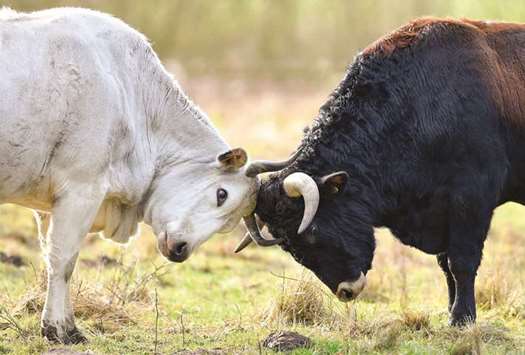At the end of the last ice age, the aurochs was the largest herbivore in Europe. The animal, with its dark coat, broad shoulders and curved horns, was a frequent inspiration for cave painters in 16th-century France.
The aurochs has long since become extinct – the last known one was shot in Poland in 1627 – but now scientists in the central German town of Lorsch want to resurrect the giant animal.
On the grounds of the Lorsch Abbey, a Unesco World Cultural Heritage Site, a project is under way to breed the aurochs back into being. Project leader Claus Kropp calculates that in 10 to 15 years’ time, animals will be born “that come very close to the aurochs.”
With their dietary habits, the herds helped create landscapes with a great wealth of biodiversity that has now all but died out in Europe, he says.
One goal of the breeding project is to inject more ecological variety into the environment. “There are answers to 21st-century questions to be found in the Middle Ages,” Kropp says.
An exhibition running until May 6 titled “The Aurochs – Searching for Traces” introduces the wild plant eaters to visitors and explains the breeding project.
The show is being held at Lorsch Abbey and is supported by the Bergstrasse-Odenwald Nature Park. Bicycle tours lead visitors to some of the cattle being used in the breeding project.
The scientists are aiming to breed species “that come as close as possible to the aurochs,” Kropp says. This applies both to their appearance and to their behaviour and genetic make-up.
Old bones have been used to gather this information. “The genome has been decoded,” says Hermann Schefers, head of the Lorsch World Cultural Heritage Site.
At the Hessen State Ministry of Science, a spokeswoman explains that most genetic characteristics of the aurochs can be located in current breeds of cattle. Through cross-breeding, a species can then be bred that comes close to the huge herbivore.
Kropp says that five breeds of cattle have been tapped for the project so far. Herds in the towns of Lorsch, Einhausen and Bielefeld have been sired by certain selected bulls and three chosen cows. Altogether, some 20 animals are being used in the project.
“We cannot resurrect extinct breeds,” admits Renate Schafberg of the University of Halle-Wittenberg. That’s why the Lorsch project goes by the name “Auerrind” – meaning “aur-cattle” – and avoids the term “aurochs.”
Scientifically speaking, the project is highly interesting. Margret Bunzel-Drueke of the nature preservation alliance, NABU, is also involved with another aurochs breeding project and comments that “theoretically we could clone them. But this is not yet possible in practical terms.”
Schafberg says the biggest problem is the size. At the highest part of their backs, aurochs bulls were up to 1.80 metres tall. They were a mixture of black and brown, or black with a bright stripe from the neck to the tail. “The horns were very large, pointing forwards and inwards,” Kropp says. The cows were coloured brown or brownish-red.
Many partners have been brought in to the project, one of them being an international breeding team in the Netherlands. Both projects are refraining from using what experts call “Heck cattle” – a species created from 15 breeds by German brothers Heinz and Lutz Heck after World War One. Kropp says these cattle are not close enough to the aurochs.
Among the breeds being used in Lorsch is the Chianina from Italy, one of the largest cattle in the world. “They do happen to be white, but in cross-breeding they quickly take on a darker colour,” Kropp says.
A further challenge is the size of the horns. The Sayaguesa, a Spanish breed, is very similar to the aurochs, but its horns are still a bit too small.
The other three breeds are the Maremmana from Italy’s Tuscany region, the Watussi from East Africa and the Hungarian Grey, with its imposing horns.
However, Kropp adds, “We don’t want to be breeding any aggressive animals.” As a result, no Spanish bullfighting bulls are being used, “regardless of how close they come to the aurochs.”
Scientists have already recorded some success when it comes to the biodiversity angle of the project – they’ve proven that the excrement of huge herbivores is an important food source for certain beetles, which in turn provide nourishment for many birds.
In the pastures being used in the project, five species of beetle that are on the red list of endangered animals have been discovered, as well as some rare birds such as the red-backed shrike.
Where the new cattle are feeding, new habitats are emerging for other life forms. Tiny microcosms have settled in their wake, and now, on warm days, amphibians are showing up. – DPA

EXPERIMENT: The Sayaguesa from Spain (right) and Chianina from Italy (left) are two of the breeds being used in a German project to recreate the aurochs.
